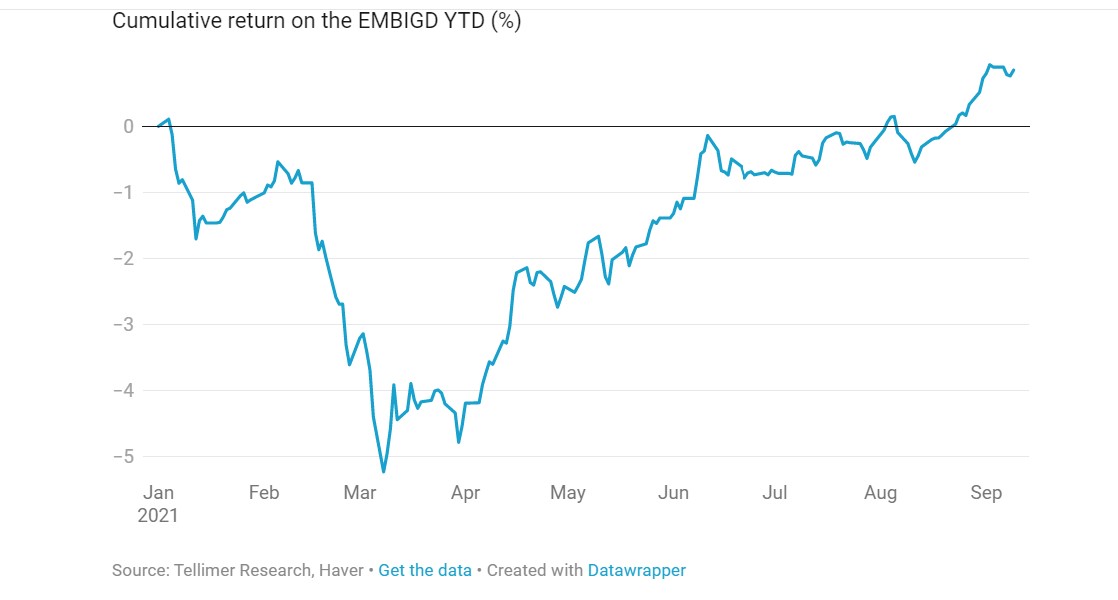By Stuart Culverhouse
–Our Top 5 picks for the rest of 2021 are Buys on Angola, Ecuador, Rwanda, Egypt (local) and Zambia (local)
–EM performance this year driven by idiosyncratic country cases
–Near-term tailwinds for EM abound, but there are risks on the horizon
Fixed Income Strategy: Top picks for Q4 2021
We present our top picks for the rest of this year – an update to our top picks for 2021, published in December. Our revised Top 5 comprises Buys on hard currency bonds in Angola, Ecuador and Rwanda, and local debt in Egypt and Zambia. Three of these are new additions (Ecuador, Rwanda, Zambia), while two picks (Angola and Egypt) are unchanged from our top picks for the year. We have removed Ethiopia, Mozambique and Sri Lanka.
The year so far
EM hard currency sovereign bonds as a whole have struggled this year, with a total return on the EMBIGD of 0.9% YTD (by the end of last week), while the EMBI spread has fallen by just 8bps this year to 344bps, although it is only 14bps wide of its stimulus-fuelled post-pandemic low (330bps), which was seen in June. Yet the EMBI spread is still some 50bps off the levels we saw immediately pre-pandemic (290bps in January 2020) and well above its all-time lows (238bps in April 2010 and January 2013), suggesting there is room for some further spread compression.
WATCH: Emerging Markets: The Dawn Of A Lost Decade | Real Turkey
However, the overall weakness masks some strong performance from idiosyncratic cases. The best performers, with returns well into double-digits, have been Zambia, Ecuador, Sri Lanka and Angola, which partly reflects catch up given how much they sold off last year, while Zambia’s rally also reflects hopes for a market-friendly outcome after the recent election.
At the other end of the scale, the worst performers have been Ethiopia (default concerns under the Common Framework), El Salvador (financing concerns amid the lack of an IMF programme), Colombia (fiscal risks) and Peru (policy outlook after the election), again reflective of some country-specific issues.
Yet, while EM financing conditions remain supportive – nominal yields on EM sovereign dollar bonds are still only c4.4%, and near-term tailwinds for EM abound from the very strong post-pandemic cyclical global recovery, the vaccine rollout and increased economic resilience to each successive new wave of infections, higher commodity prices and still supportive global monetary conditions – there are risks on the horizon.
These risks include from Covid itself (with new strains or weakened immunity from vaccinations), rising debt burdens in many EM (especially low-income countries), higher global and EM inflation (with concerns about bottlenecks amid the rapid post-pandemic recovery), prospects for fading global policy stimulus (both fiscal and monetary) and a Chinese slowdown.
In particular, while we think systemic risks from a repeat of the Taper Tantrum are overblown, frontier and smaller EM are especially vulnerable to higher global interest rates as the US Fed looks to withdraw monetary stimulus. Meanwhile, sovereign defaults have been few (and those that have occurred this year – two of them – are essentially ongoing from last year) and we haven’t seen a wave of countries rush to the Common Framework to copy Ethiopia’s lead.
Excerpt, link to full article here
